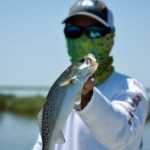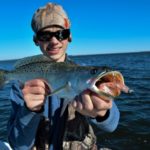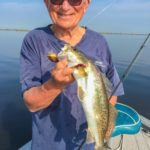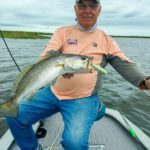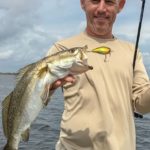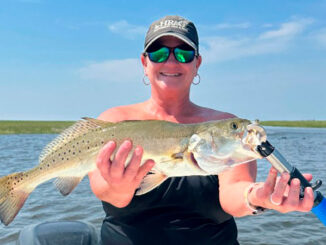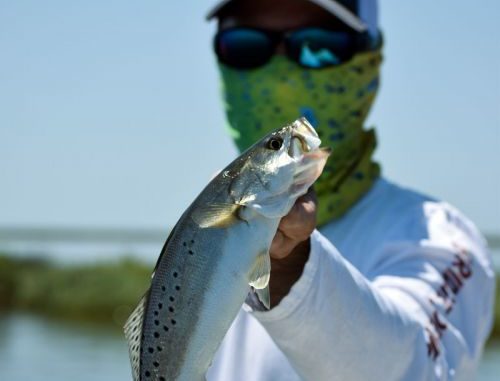
The spring transition can be tough on Delacroix trout anglers, but these three lures up your odds of success — if you know where to use them.
MirrOLure She Dogs are made with premium hardware, rattles that can be heard from space, natural 3-D eyes, double-dipped MirrOclear exterior finishes and — above all — durable, life-like colors.
I put that last characteristic to the test on a recent March morning trip out of Sweetwater Marina in Delacroix. It was a breezy day, so the fish wanted nothing but the loudest topwaters in the box.
Once we established the pattern, the fish were clobbering my blue back/chrome body She Dog.
By the end of the trip, the ferocious, aggressive speckled trout had created a custom color you won’t find in any store across the country if your life depended on it.
I wouldn’t have wanted my topwater to look any other way, and I am forever grateful to Arthur Borchgrevink for putting me on gorilla-sized speckled trout when most guys are complaining about it being March.
Borchgrevink fishes areas this time of year most people wouldn’t dream of for speckled trout. Instead of working traditional lakes and bays, which hold decent numbers of speckled trout in March, he focuses on ponds that are absolutely chock-a-block full of specks.
“In March, the ponds are clean, but they’re not choked up with grass, and the fish are in there big-time,” he said.
Being too full of grass can be a negative in ponds. Sure, the grass filters the water, but trying to get any lure through it if it gets too thick is next to impossible.
Throughout a good portion of the year, Borchgrevink fishes these ponds — and they are definitely on his to-do list in the spring.
“I’ll move over to the lakes in another month, but the ponds should be good through the end of April — as long as they don’t get choked up with grass,” he said.
He looks for two key ingredients: Find those, and you’ve located the fish.
“I normally look for a pond that has bait and grass,” Borchgrevink said. “Those fish are going to be just above the grass or right on the outside of it feeding on the bait that homesteads in the grass.”
Of course, major cold fronts and west winds can put a dent on water levels in Delacroix. That means that March fronts can hurt the fishing action in the ponds.
“I like the water level to be normal or high,” Borchgrevink said. “It tends to stay clean, and the fish can roam around in the grass a lot easier. If it’s super low, they get out of those ponds and congregate in those deeper channels.”
The type of bait he for is glass minnows that are typically a little over an inch long. However, he said to not be surprised if you see small crustaceans mixed in with them.
“In early March of last year, we still saw some shrimp in there popping,” he said. “But, always, the fish we cut open in March are full of glass minnows.”
Here’s a rundown of how this die-hard angler consistently catches trout during his Delacroix forays this month.
Crank ’em up
Although a speckled trout here and there will occasionally hit a spinnerbait, it’s not ideal for catching Louisiana’s favorite fish.
Big, bulky and unrealistic-looking with more hardware than ACE, spinnerbaits are not the best lures for speckled trout, especially in the clear-water ponds.
But a lure that works very well for Borchgrevink — believe it or not — is a realistic crankbait, a lure catered to freshwater fishermen.
The specific type of crankbait he uses is called a wake bait. Characterized by its ability to run ultra-shallow, this lure is perfect for grassy ponds all across the coast.
Borchgrevink always has a crankbait tied on this time of year in Delacroix.
“The main advantage of it is that it only runs about 6 inches under the surface, and it doesn’t catch all of the grass,” he said. “You’re travelling between the surface of the water and above the grass.
“Those fish will see that bait coming above them, and they’ll smash it.”
Borchgrevink’s favorite brand is the H2O Express. He implements a steady retrieve that isn’t exactly at a snail’s pace.
“You have to crank fast enough or the bait won’t wobble correctly,” he said.
Another good quality of the bait is the noise it makes, he said.
“They have rattles in them, which you can hear well,” Borchgrevink said. “The rattles attract the trout, redfish and bass.”
The best colors on the crankbaits are the gold and blue/white, he said.
“If I had to take just one to use, I would bring the gold one,” Borchgrevink said.
Because there’s generally a lot of grass in the ponds he fishes, the angler rarely has a problem finding clean water. However, pristine water clarity isn’t necessary for the crankbaits.
“The water doesn’t have to be really clean, and they’ll knock the fire out of it because of the vibration — it wobbles back and forth,” he said.
Borchgrevink also noted a crankbait tends to trigger bites from larger speckled trout compared to soft-plastic baits.
But crankbaits aren’t the only hard-plastic lures pond specks find attractive this time of years.
There’s truly nothing like a good topwater bite, and that’s something Borchgrevink does frequently while fishing the Delacroix ponds throughout the spring.
Topwater destroyer
Once the fish — for some unidentified reason — turned their noses at the crankbait, Borchgrevink moves to destroying them on topwaters.
His favorite topwater ponds feature about 4-foot-deep water, grass and mullet.
“I like clean water, but I also like for there to be a chop on the surface — not glass calm,” Borchgrevink he said. “(The chop) hides the lure, and they can’t make it out to be a fake. It also distorts the light, which helps you when you’re casting and retrieving.
“I find the chop improves the bite.”
Borchgrevink walks the dog with She Dogs. With deafeningly loud rattles, this bait is ideal for a wavy surface on a windy day.
Favorite colors are bone, chartreuse/green head and blue/chrome. He particularly likes the chrome colors when clouds give away to a bright Helios.
“When the sun comes out, I’ll switch from bone to chrome,” Borchgrevink said. “It makes a big difference.”
And a topwater is a superior big-fish bait, he said.
“Every now and then, you’ll luck out and get a 5-pound trout in there,” Brochgrevink said. “You’re going to get it on that topwater faster than anything.”
The numbers game
Topwater baits offer some heart-stopping strikes that are certainly a blast to watch. However, if you’re looking for a fish fry to feed your extended family, topwaters are probably not the way to go.
Not all fish — particularly the small trout — are going to have the energy to break the surface and hit a relatively large mullet.
So when going for quantity, Borchgrevink doesn’t hesitate to change rigs.
“If you’re looking for numbers, I’d definitely go with a cork,” he explained.
He is adamant about fishing long leaders under his corks. In fact, if the leader is only a couple inches too short, he cuts it off and ties a new one.
He typically uses a 32-inch section of 20-pound fluorocarbon tied to a ¼-ounce jighead tipped with ultraviolet or shrimp creole Matrix shads.
“I think what’s happening is the current is moving that ¼-ounce jighead just off the bottom, and when you pop the cork, the bait comes up in the (water column) and the fish hammer it,” Borchgrevink said.
Since the bait is near the bottom, the fish can’t exactly pull the cork straight under. So paying close attention to your cork will result in fewer lost fish.
“It will look like a perch bite sometimes,” Borchgrevink said. “It’ll go left or right or may start to go under, and then I just start reeling.”
